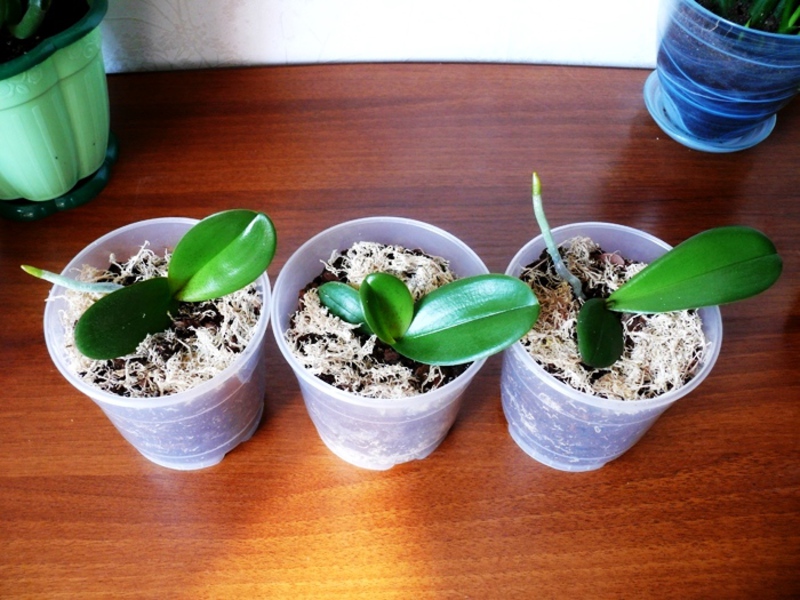Every gardener who loves exotic crops is faced with the issue of plant transplantation. This procedure is a prerequisite for growing them and is just as important for the health of the flower as watering, humidifying the air, lighting and temperature.
The tropical beauty orchid is no exception. The transplant requires preliminary preparation and consists of several stages. If this is done in accordance with the rules, then success is guaranteed and you can continue to admire its beautiful flowering.
Content
Why you need to transplant orchids
 Remember that transplanting a plant into a new container is stressful for the flower. This leads to the fact that indoor orchids get sick and the development of roots stops for a while.
Remember that transplanting a plant into a new container is stressful for the flower. This leads to the fact that indoor orchids get sick and the development of roots stops for a while.
In this regard, the transplant should be performed no more than once every two to three years. If the transplant is going according to plan, it is better to postpone it in the spring, when the plant enters the phase of active growth.
The soil where the orchid grows depletes over time and loses such important characteristics as the optimal acidity level, the balance of mineral salts, and the necessary air permeability. Over time, it begins to decompose, thicken and no longer controls the habitat of the root system.
In this regard, constant waterlogging can cause root rotthat will end with the death of the flower. It is worth knowing that each soil has its own properties, therefore, a certain scheme for its replacement is required.
So, if the main component of the soil is bark, then it is changed for a new one every three years. When there is a large amount of sphagnum moss in the substrate, it is replaced more often - once every two years.
Orchids grown at home in pots so cramped that roots remain outsiderequire a transplant. After all, the root system develops no worse than the ground part - leaves and peduncles.
This leads to the fact that the soil under the pressure of overgrown and intertwined roots, is displaced. These circumstances have a very negative effect on the overall life of the flower, so the best solution would be totransplanting into a larger container.
Emergency plant transplant
The orchid should be immediately transplanted into a new substrate in the following cases:
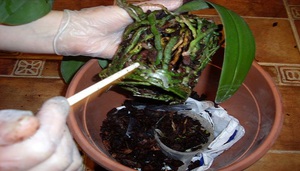 When the soil decomposed and began to resemble dust.
When the soil decomposed and began to resemble dust.- Uninvited guests such as scale insects, thrips, nematodes and other pests appeared in the flowerpot.
- As a result of a violation of the irrigation regime, the roots of the exotic began to rot.
- The green part of the plant that has grown beyond the borders of the pot in width.
Many novice flower growers are interested in whether it is necessary to transplant a newly purchased plant?
Experienced florists advise to postpone the transplantif your tropical friend looks healthy and strong. Since most often we acquire a blooming beauty, and during this period it is better not to disturb the flower.
Basic rules for orchid transplant
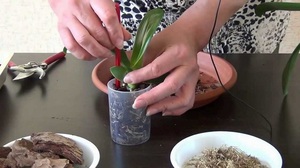 How to transplant an orchid at home? Planting a plant in a new container is a matter responsible and requires preparation... Beginning florists are encouraged to study the flower care video on this process.
How to transplant an orchid at home? Planting a plant in a new container is a matter responsible and requires preparation... Beginning florists are encouraged to study the flower care video on this process.
If you plan to transplant a freshly bloomed orchid, then its peduncle need to be carefully trimmed... This is required so that during the period of adaptation, the exotic used up all the energy to restore vitality.
In the preparatory stage before landing, you should do selection of the necessary tools... For this you need the following:
- well-sharpened scissors or a small sharp pruner;
- a transparent plastic pot, larger than the previous one;
- new soil;
- activated carbon tablet or alcohol-free bactericidal preparations.
All tools should be disinfect, that is, treat with alcohol. Thus, you will protect the exotic beauty from germs.
Step by step instructions and video
How to transplant an orchid? It is necessary to transplant a culture in several stages:
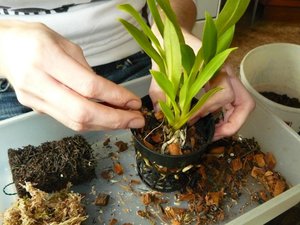 First, remove the orchid from the old container. This must be done carefully, without damaging the root system of the flower. To do this, the pot must be gently crumpled with your hands to separate the soil and roots from its walls. If it is not possible to do this carefully, without injuring the roots, then you will have to resort to scissors and cut the pot into pieces.
First, remove the orchid from the old container. This must be done carefully, without damaging the root system of the flower. To do this, the pot must be gently crumpled with your hands to separate the soil and roots from its walls. If it is not possible to do this carefully, without injuring the roots, then you will have to resort to scissors and cut the pot into pieces.- It is necessary to clear the roots of the old soil. It is better to transfer this process to the bathroom, where, under running water, it will successfully separate from the roots without causing pain to the flower.
- After that, we carefully examine the root system of the orchid. Since they can hide pests. In order for the plant to develop well in the future, one should learn to get rid of them.
- If a parasite was found on the roots, before planting in the ground, the flower should be immersed in warm filtered water for several hours. Most pests will not tolerate such execution and will die. After that, the orchid is treated with a special remedy for this type of pest.
- After examining for the presence of insects, we turn to the diagnosis of the roots themselves. Dry or rotten roots are removed. Dead roots are carefully trimmed with scissors, the cut sites are treated with activated charcoal or an antibacterial drug.
- Before planting, you need to remove the lower leaves, which look lifeless and yellow. There will be no benefit from dried foliage, but it will be able to prevent planting in a new container. Soft hollow bulbs should also be trimmed. In the same way as they did with the roots, the cut sites are treated with disinfectants.
- It is necessary to transplant the orchid into new soil only after thoroughly drying the roots. It should take at least eight hours.
Transplant process
Choosing the right pot is the key to a successful transplant. It should be transparent from a plastic material and a few centimeters larger than the previous one. The container needs to be disinfected and place a drainage layer on the bottom, a little.
Place the flower in the middle of the flowerpot and gently pour the substrate into it. Care must be taken to ensure that the substrate evenly distributed between the roots. At the same time, keep an eye on the point of growth of the orchid, it should remain in sight.
If your pet has well-developed aerial roots, they do not need to be buried in the ground. Do not try to tamp the ground very hard, over time the root system will fix itself in it. However, it must be borne in mind that the orchid should not hang out in the pot.
Reproduction of orchids
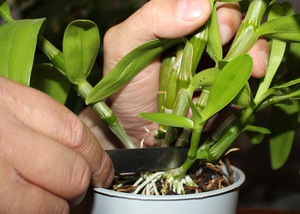 Orchid transplant can be accompanied by reproduction. You can make several from one bush. Orchids growing at home are very whimsical creatures, but knowing certain rules, they can be propagated.
Orchid transplant can be accompanied by reproduction. You can make several from one bush. Orchids growing at home are very whimsical creatures, but knowing certain rules, they can be propagated.
If you do not know how to do this, watch the training video, after which you will have confidence in your abilities.Professional florists assure that a tropical guest living in indoor conditions can be propagated in four ways.
The most popular breeding method is separation by stems... After the plant sheds peduncles, small baby cuttings can be found in the pot. It is they who will soon turn into a tropical beauty if planted in another pot.
You can propagate the plant dividing roots... This method is only suitable if the root system and bulb have grown well. In this case, an equal part is cut off and deposited in another pot.
Another reliable way is to reproduce by side escape... After the orchid blooms, it is cut off and placed in warm and moist soil for several weeks. After this time, you can start planting a flower.
Post-transplant care
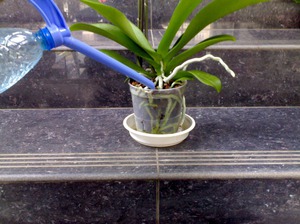 In order for a plant to have a successful recovery period, it must be provided with the necessary care. Plant needed put in the shade and protect from solar influences. The room temperature should not exceed 20-22 degrees.
In order for a plant to have a successful recovery period, it must be provided with the necessary care. Plant needed put in the shade and protect from solar influences. The room temperature should not exceed 20-22 degrees.
Better if the transplanted orchid was on the east window. Watering after planting should be done after 4–5 days.
Leaves should spray with warm purified water... Within a month, the orchid needs useful fertilizers.
So, orchid transplantation is a necessary process that affects the development of a tropical beauty, the further life and health of the plant depends on it. And subsequent proper care will ensure a short recovery period from stress.

